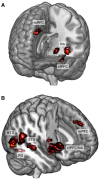Temptations of friends: adolescents' neural and behavioral responses to best friends predict risky behavior
- PMID: 29846717
- PMCID: PMC6007330
- DOI: 10.1093/scan/nsy028
Temptations of friends: adolescents' neural and behavioral responses to best friends predict risky behavior
Abstract
Adolescents are notorious for engaging in risky, reward-motivated behavior, and this behavior occurs most often in response to social reward, typically in the form of peer contexts involving intense positive affect. A combination of greater neural and behavioral sensitivity to peer positive affect may characterize adolescents who are especially likely to engage in risky behaviors. To test this hypothesis, we examined 50 adolescents' reciprocal positive affect and neural response to a personally relevant, ecologically valid pleasant stimulus: positive affect expressed by their best friend during a conversation about past and future rewarding mutual experiences. Participants were typically developing community adolescents (age 14-18 years, 48.6% female), and risky behavior was defined as a factor including domains such as substance use, sexual behavior and suicidality. Adolescents who engaged in more real-life risk-taking behavior exhibited either a combination of high reciprocal positive affect behavior and high response in the left ventrolateral prefrontal cortex-a region associated with impulsive sensation-seeking-or the opposite combination. Behavioral and neural sensitivity to peer influence could combine to contribute to pathways from peer influence to risky behavior, with implications for healthy development.
Figures



References
-
- Bakeman R., Quera V. (2011). Sequential analysis and observational methods for the behavioral sciences. New York: Cambridge University Press.
-
- Blakemore S.J., Robbins T.W. (2012). Decision-making in the adolescent brain. Nature Neuroscience, 15(9), 1184–91. - PubMed
Publication types
MeSH terms
Grants and funding
LinkOut - more resources
Full Text Sources
Other Literature Sources
Medical
Miscellaneous

